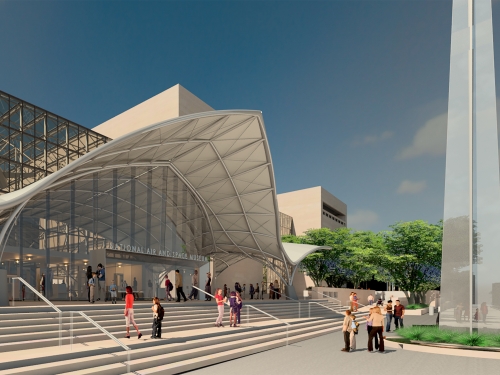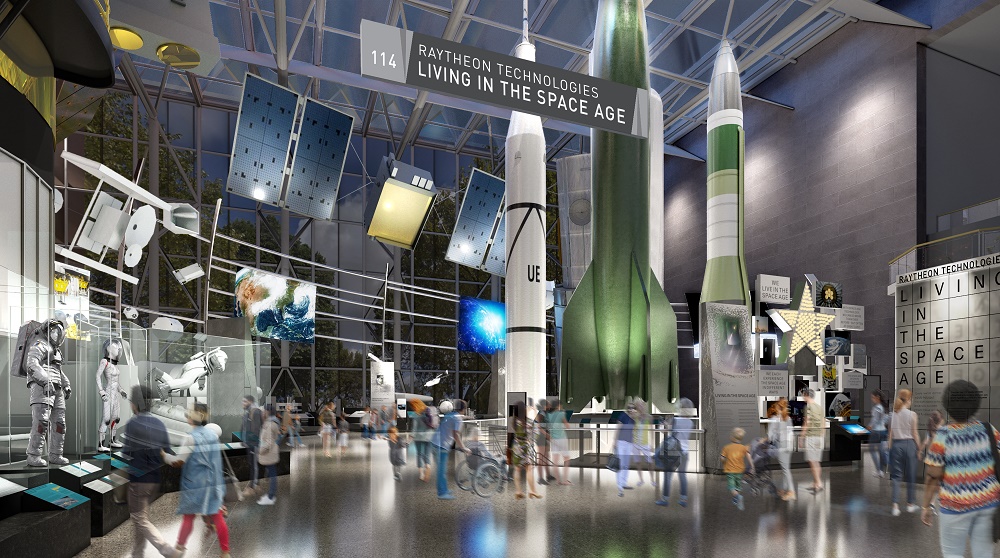
National Air and Space Museum Receives $25 Million Gift From Raytheon Technologies
The Smithsonian’s National Air and Space Museum has received a $25 million gift from Raytheon Technologies to support the creation of its new “Living in the Space Age” exhibition. The exhibition is located in one of the museum’s three main halls and will show visitors how innovations in space technology have transformed their lives, and why it matters. The “Raytheon Technologies Living in the Space Age” exhibition is part of the museum’s ongoing transformation of its galleries at the flagship building in Washington, D.C., and scheduled to open in 2025. The gift will also sponsor the Explainers program, the museum’s frontline program for STEM (science, technology, engineering and math) engagement with visitors onsite and online. The museum and Raytheon Technologies announced the gift today, April 6, at the Space Foundation’s annual Space Symposium in Colorado Springs, Colorado.
“We are grateful for Raytheon Technologies’ generous support, which is so critical to helping us engage more deeply with visitors,” said Lonnie Bunch, Secretary of the Smithsonian. “This gift will not only help us bring the wonder of the space age to audiences of all ages, I am confident it will inspire a greater desire to learn about the STEM disciplines increasingly needed in the dynamic workforce of today and tomorrow.”
The “Raytheon Technologies Living in the Space Age” exhibition will provide insight into space hardware and infrastructure that are largely invisible to the public but have a profound impact on their daily lives. The exhibition will explore topics from the beginning of the Space Age in the mid-20th century to the present and beyond. It will narrate these stories through Space Age objects and the people who build, maintain and use them. The content will include the development of large-scale rocket technology during and after World War II, ballistic missiles that resulted from Cold War development and vehicles that allowed the launching of satellites and astronauts into space and space systems for Earth observation, communications and navigation. Some of the key artifacts will include the Hubble Space Telescope, Skylab Orbital Workshop, Standard Missile-3 and several generations of EVA (extravehicular activity) spacesuits.
“With a renewed focus on space exploration, tomorrow’s technology solutions will be built on the lessons of what got us to the moon and beyond,” said Raytheon Technologies Chairman and Chief Executive Officer Greg Hayes. “By working with the Smithsonian to inspire and educate the next generation of innovators, we will accelerate and expand what is possible on Mars and countless other new frontiers.”
The 11,800-square-foot gallery will be a hub for STEM learning through interactive programming led by the museum’s Explainers. The Explainers program hires high school and college students to help visitors better understand the concepts surrounding the museum’s artifacts and exhibits through hands-on activities. Explainers host demonstrations, design challenges and other activities throughout both of the museum’s locations and online.
“Raytheon Technologies’ transformative gift will help us reimagine one of the museum’s most popular galleries for the next generation of innovators,” said Chris Browne, acting director of the National Air and Space Museum. “The large-scale artifacts on display in the gallery will create a powerful sense of awe and allow us to tell stories about how space exploration affects us all.”
More information is available about how the museum is transforming all of its exhibitions and revitalizing its National Mall building.The National Air and Space Museum in Washington, D.C., is located at Sixth Street and Independence Avenue S.W. The Steven F. Udvar-Hazy Center is located in Chantilly, Virginia, near Washington Dulles International Airport.
# # #
SI-70-2022

